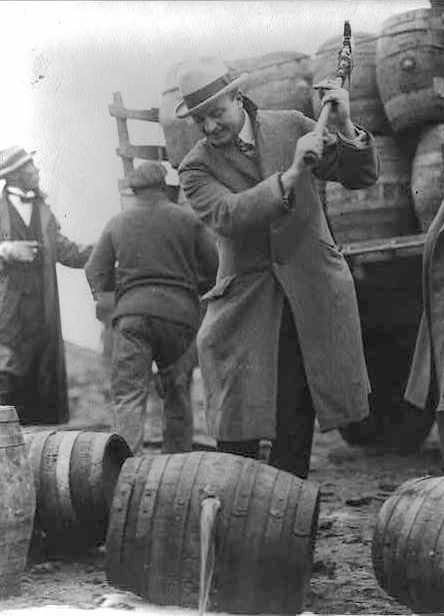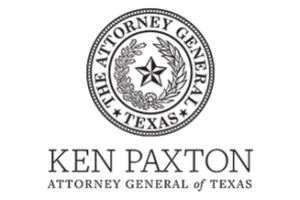
Photo courtesy of the Library of Congress

On January 16, 1920, in accordance with the 18th Amendment to the U.S. Constitution, the National Prohibition Act (also known as the “Volstead Act”) enforced the prohibition against the production, importation, transportation, and sale of alcoholic beverages in the United States. For the next 13 years, halting the flow of illegal alcohol proved to be the bane of the nation’s Prohibition agents but a boon for organized crime, speakeasies, and bootleggers.
Religious and temperance groups advocated prohibiting the sale and consumption of alcohol in the United States as early as the first decades of the 19th century. Maine became the first state to outlaw the sale of alcoholic beverages (except for industrial and medicinal purposes) in 1846. Following the 1873 founding of the Woman’s Christian Temperance Union  (WCTU), first president Annie Wittenmyer worked to raise awareness of alcohol’s role in the rising number of spousal abuse incidents. Eight years later, the WCTU succeeded in lobbying Kansas’ legislators to prohibit the manufacture of alcohol in the state.
(WCTU), first president Annie Wittenmyer worked to raise awareness of alcohol’s role in the rising number of spousal abuse incidents. Eight years later, the WCTU succeeded in lobbying Kansas’ legislators to prohibit the manufacture of alcohol in the state.
In 1893, the fight against alcohol gained a new and powerful ally in Rev. Howard Hyde Russell who founded the Anti-Saloon League in Oberlin, OH. The organization’s rapid expansion and political influence coincided with the spike in corruption, prostitution, domestic violence, and vagrancy that city dwellers witnessed in the nation’s fast growing urban centers. Aggressive lobbying by the Anti-Saloon League and the WCTU—along with their alliance with the Women’s Suffrage Movement—led Oklahoma, Georgia, Mississippi, North Carolina, and Tennessee to pass prohibition legislation during the first decade of the 1900s. Limitations on the availability of alcoholic beverages during World War I helped anti-alcohol advocates convince Congress that the nation needed lasting federal prohibition legislation.
On August 1, 1917, a U.S. Senate-passed resolution proposed language for a constitutional amendment prohibiting the sale, manufacture, and distribution of alcoholic beverages in the United States. A revised resolution passed the U.S. House of Representatives and Senate on December 18, 1917. Many states already had local legislation regulating alcohol, so state legislatures quickly affirmed the amendment. Mississippi was first to affirm the amendment on January 7, 1918, and Nebraska’s approval on January 16, 1919, made nationwide Prohibition the law of the land. One year after the 18th Amendment’s ratification, the United States went “dry” on January 16, 1920.
The 18th Amendment nationalized prohibition, but because it did not define the term “intoxicating liquors,” federal and state governments were required to determine methods for enforcing the law. When voting for the 18th Amendment in 1917, many Americans and members of Congress assumed the legislation referred only to “hard liquor” and exempted beer and wine. However, thanks to the lobbying efforts of Anti-Saloon League leader Wayne Wheeler, the prohibition against “intoxicating liquors” encompassed any beverage containing more than .5 percent alcohol. The House of Representatives and Senate passed the National Prohibition Act (popularly known as the “Volstead Act”)—coauthored by Wayne Wheeler—on July 22 and September 5, 1919, respectively. Expressing concerns that the Volstead Act infringed upon American’s civil liberties, President Woodrow Wilson vetoed the bill on October 27, 1919. The House of Representatives overrode the president’s veto within hours. Following the Senate’s vote to override Wilson’s veto, the Volstead Act became law on October 28, 1919.
Over the next 13 years, more than 1,500 prohibition agents like Eliot Ness, Tom Threepersons, and Frank Hamer (famous for tracking down notorious outlaw couple Bonnie and Clyde) attempted to enforce the Volstead Act while bootleggers and gangsters like Al Capone, Charles “Lucky” Luciano, Benjamin “Bugsy” Siegel, Enoch “Nucky” Johnson, Arnold Rothstein, and Carlo Gambino thumbed their noses at the 18th Amendment. Despite vigorous enforcement efforts that included the seizure of more than 1 million gallons of illegal alcohol and the arrest of thousands of gangsters and bootleggers, America’s taps continued to flow and organized crime flourished.
By the early 1930s, the United States was locked in the grip of the Great Depression and Americans were growing increasingly weary of the violence associated with Prohibition. More importantly, Congress began reexamining the value of tax revenues generated by the manufacture and sale of alcohol. Members of Congress introduced dozens of bills to amend the Volstead Act or repeal the 18th Amendment. During the 1932 Presidential Election, Democratic candidate Franklin D. Roosevelt told supporters it was “time to correct the ‘stupendous blunder’ that was Prohibition.” Incumbent Republican candidate Herbert Hoover was unwilling to voice a similar belief for fear of alienating anti-alcohol voters.
On November 8, 1932, Roosevelt defeated Hoover in a landslide victory, garnering more than 57 percent of the vote and carrying 42 of the nation’s 48 states. In February 1933, Congress passed the Joint Resolution Proposing the 21st Amendment to the United States Constitution (“Blaine Act”) proposing the repeal of the 18th Amendment. Less than 3 weeks after moving into the White House, President Franklin D. Roosevelt signed the Cullen-Harrison Act 


You can learn more about Prohibition and the intoxicating beverages that led to its passage and repeal using census data and records. For example:
- The 18th Amendment to the U.S. Constitution was ratified on January 16, 1919, and the Volstead Act set the starting date for nationwide prohibition on January 16, 1920—16 days after the United states conducted the 1920 Census. In 1920, the United States was home to 106,021,537 people. When Congress proposed the 21st Amendment to the U.S. Constitution on February 20, 1933, and the states ratified it on December 5, 1933, the nation’s population had grown to 123,202,624.
- One day before ratification of the 18th Amendment, a massive storage tank containing 2.3 million gallons of molasses used to produce industrial alcohol burst in the “North End” neighborhood of Boston, MA . Its contents surged into the neighborhood, engulfing everything in its path, suffocating onlookers, and washing terrified victims into the harbor. Rescuers spent days sifting through the wreckage as they searched for the injured and dead, and did not recover the last victim from the harbor until May 12, 1919. The disaster has since been known as “The Great Boston Molasses Flood of 1919”.
- Organized crime bosses made fortunes controlling the manufacture, importation, and sale of alcohol in major American bootlegging cities like New York, Philadelphia, and Chicago. Between 1890 and 1950, the three cities ranked as the United States’ most populous. New York’s population grew from 5,620,048 in 1920 to 7,891,957 in 1950. Today, New York City, NY is home to 8,398,748. Chicago’s population grew from 2,701,705 in 1920 to 3,620,962 in 1950. In 2018, Chicago was home to 2,705,994. In 1920, Philadelphia’s population was 1,823,779. It grew to 2,071,605 in 1950, and today boasts a population of 1,584,138.
- According to Title 27, U.S. Code, a barrel of beer contains 31 gallons of the sudsy beverage. American breweries produced a pre-Prohibition high of 286,100,000 barrels of beer in 1917. That total fell to a Prohibition low of 2,766,000 barrels in 1932. One year after the 21st Amendment to the U.S. Constitution ended Prohibition, American breweries produced 37,678,000 barrels of beer.
- The National Prohibition Act—also known as the Volstead Act—specifically exempted the manufacture, sale, transportation, importation, possession, and distribution of alcohol used for sacramental and religious rites, medicinal uses, and scientific research. As a result, the production and sale of distilled spirits for these uses (including industrial alcohol) rose from 100,800,000 taxed gallons in 1919 to 203,800,000 taxed gallons in 1926. When national Prohibition ended in 1933, American distilleries produced 123,405,00 taxed gallons of spirits.
- Data based on the 2017 County Business Patterns found the United States was home to 34,510 beer, wine, and liquor stores (NAICS 4453) employing 170,474 employees. These establishments sold the products produced by the nation’s 3,305 breweries (NAICS 31212), 783 distilleries, and 3,708 wineries (NAICS 31213).
- Thanks to diligent enforcement of the “Volstead Act” by the nation’s 1,500 prohibition agents, convictions related to the manufacture, sale, and transportation of alcohol contributed to a rapid rise in the number of people in state and federal prisons. According to the Statistical Abstract of the United States, the number of people in state and federal prisons rose from 68,735 in 1910 to 81,959 in 1923; 120,496 in 1930; and 171,627 in 1940. Two of these prisoners were Charles “Lucky” Luciano and Alphonso Capone—perhaps one of the most Prohibition-era’s most famous criminal masterminds—who avoided bootlegging charges and was instead prosecuted for tax evasion in 1931.
- Ratification of the 21st Amendment ended Prohibition in the United States on December 5, 1933. Although federal laws permit the manufacture, sale, and consumption of alcohol, many American counties remain “dry.” Dry counties prohibiting the sale of all alcoholic beverages include Wichita County, KS; Monroe County, KY; Choctaw County, MS; Craighead County, AR; and Hemphill County, TX. Many other states and counties continue to enforce Colonial-era “Blue Laws” restricting the sale of alcohol and other activities on Sundays and holidays for religious or secular reasons. For example, residents of Anne Arundel County, MD, (and many other Maryland counties) can not purchase a new or used car on Sunday; Adair County, OK, residents can not purchase alcohol or a car on Sundays and certain holidays; and Fairfax County, VA, prohibits stores from selling alcohol between 12:00 and 6:00 a.m. daily.
- According to the 2017 National Survey on Drug Use and Health, more than 86 percent of people aged 18 or older reported that they drank alcohol at some point in their lifetime. Between 2006 and 2010, the Centers for Disease Control reported that 88,129 people died due to excessive alcohol use.















